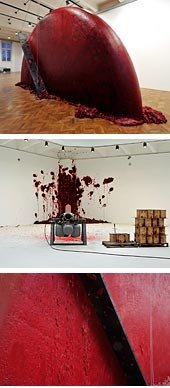Anish Kapoor
dal 19/1/2009 al 18/4/2009
Segnalato da
19/1/2009
Anish Kapoor
MAK Austrian Museum of Applied Arts / Contemporary Art, Wien
Shooting into the Corner

Curator Bettina M. Busse
Anish Kapoor, born 1954 in Bombay (today Mumbai), ranks among the most
important sculptors of the present. His upcoming exhibition at the MAK
presents new room-filling wax works of the artist who lives in London today.
The central work featured in the show, “Shooting into the Corner” (2008/09),
will be on view in the large Exhibition Hall; the pieces “Past, Present, Future”
(2006), “Push-Pull II” (2008/09), and “Shadow Corner” (2008/09) will be shown
in adjacent exhibition rooms. The three works of 2008/09 were created
especially for the MAK exhibition.
“Shooting into the Corner” consists of a cannon developed by Kapoor together
with a team of engineers. A pneumatic compressor shoots 11-kilogram balls of
wax into the corner across the room; all in all, 20 tons of wax will be “fired
away” throughout the exhibition run. The ball shape of the wax projectiles
changes when they hit the wall; one part will stick to the wall. So a mound of
wax will gather on the floor and keep piling up.
Loud aggression on the one hand and silent growth on the other give the
piece tension, sensuality, and compelling power. Transcendental experiences
such as change, transience, and new start add to the intense physical
impression.
In “Past, Present, Future”, by contrast, material is taken off. A motor-driven
steel plate peels off layer after layer of a blood-red huge hemisphere of wax
with one move of the arm taking a full hour.
A similar principle is used in the object “Push-Pull II” which also consists of a
semicircle and a cut-out rectangle. Here, too, material is removed, but the
oversized metal scraper moves across the mass of wax a couple of times only
before it is locked in position with a metal suspension. The state of the work
then is not changed any more throughout the exhibition.
“Shadow Corner” again is a work in progress that plays on the encounter of a
square and a semicircular segment. A negative form is continuously hollowed
out by an automatic arm in an extremely slow movement. The exhibition visitor
does not get a final impression of the work, but a temporary view with an
uncertain outcome the final aspect of which he or she can only imagine.
The four works in the exhibition show strong affinities in that the geometrical
shapes of sphere, semicircle, and square play an important role in all of them.
“Shooting into the Corner” uses a spherical cannon ball, and in “Past, Present,
Future” the spherical shape is absolutely dominant.
Since the 1980s, Kapoor has produced sculptures that were inspired by the
land of his birth, India, and poetical in an abstract way, exploring the
interrelation of object, picture, and idea. The themes that inform his work—
emptiness, transformation, immateriality, faith or passion—derive from
painting and go far beyond mere issues of form. The fascination of his works
is also based on his characteristic use of color.
Anish Kapoor is an artist whose range of materials is very broad, reaching
from ephemeral pigment, mirror objects and wax to fiberglass, stone, PVC and
polished stainless steel. No less conspicuous than his sense of experimen-
tation in this respect is his way of exploring space and modes of perception.
However different the individual groups of works may be in their materiality or
immateriality, for Kapoor these apparent antagonisms are part of a larger
whole that he devotes himself to in order to discover something new. Many of
his pieces are informed by his philosophy of concealment. He addresses the
absent and invisible. Despite their powerful materiality, his works contain the
allusive reference, the spiritual and transcendent that goes far beyond what is
tangible and superficially visible in his objects.
Confrontation with the public is becoming increasingly more important for
Kapoor. Despite the apparently simple shapes, viewers are unsettled in their
perception and forced to complement, or continually relativize, their
impressions with new views over and again. This game is even made worse
when the time component is involved—when a work exhibited keeps changing
in the course of the show. What all four sculptures have in common is the
processual character of material being piled up or taken off.
Kapoor, who studied at a number of renowned art schools in India and in
England, counts among his influences works by artists such as Beuys and
Barnett Newman as well as motifs from Far-Eastern culture. In 1990, he
represented Great Britain at the 44th Venice Biennale and received the
coveted “Premio 2000” from the International Jury. In 1991, he was awarded
the prestigious Turner Prize. One of the high points of the 1992 documenta IX
1992 in Kassel, Germany, was his space entitled “Descent into Limbo”. He
also created a furore with works like his monumental “Marsyas” sculpture,
shown 2002 at the Tate Modern’s Turbine Hall in London, or “Cloud Gate”, a
110-ton stainless steel construction that has been on permanent display at
Millennium Park in Chicago since 2004. Besides, Anish Kapoor frequently
works on architectural projects. Currently, two subway stations designed by
him are being built in Naples, Italy.
The exhibition will be accompanied by two publications:
The book-market edition of the catalogue will come out in March 2009:
“ANISH KAPOOR. Shooting into the Corner”, ed. by Peter Noever, with
contributions by Vito Acconci, Bettina M. Busse, Peter Noever, August Ruhs,
Burghart Schmidt, Gabriel Ramin Schor, and Michael Stavaric,
German/English, approx. 208 pages, approx. 150 color illustrations, MAK
Vienna/Hatje Cantz, Ostfildern, 2009.
MAK-Press office
contact: Monika Meryn (Head), Olivia Harrer
Stubenring 5 A-1010 Vienna phone (+43-1) 711 36-229 fax (+43-1) 711 36-227 e-mail: presse@MAK.at
Press Preview Tuesday, 20 January 2009, 10:30 a.m.
Opening Tuesday, 20 January 2009, 8:00 p.m.
MAK Exhibition Hall
Weiskirchnerstraße 3, A-1010 Vienna
Opening Hours
Tue MAK NITE© 10:00 a.m.–12:00 p.m.
Wed–Sun 10:00 a.m.–6:00 p.m., Mon closed



